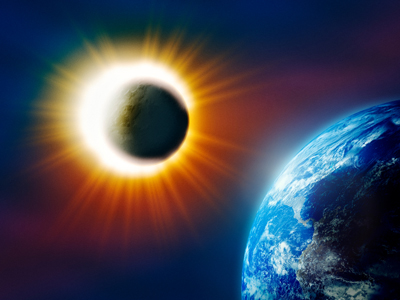

Have you ever seen an eclipse?
Space - Moon and Eclipses
This Science quiz is called 'Space - Moon and Eclipses' and it has been written by teachers to help you if you are studying the subject at middle school. Playing educational quizzes is a fabulous way to learn if you are in the 6th, 7th or 8th grade - aged 11 to 14.
It costs only $19.50 per month to play this quiz and over 3,500 others that help you with your school work. You can subscribe on the page at Join Us
As you may recall from lessons in school, the Moon is a natural satellite of the Earth. Its rotation synchronizes with the Earth’s. It is also the second brightest object in the Earth’s sky right after the Sun. In addition, you learned that the Moon orbits around the Earth once every 27.3 days. Because the Earth is also rotating and orbiting around the Sun, the phases of the Moon occur about every 29.5 days. This quiz will not be on the Moon and its phases but, rather, on the Moon and eclipses. However, the Moon’s phases do directly relate to eclipses.
Lunar Eclipse
A lunar eclipse will happen when the Earth passes between the Moon and the Sun. This generally happens during the Full Moon phase and it can be observed almost everywhere on Earth. A lunar eclipse can also last for a few hours.
Types of Lunar Eclipses include:
1. Total Lunar Eclipse: This is when the Moon travels completely into the Earth’s umbra (shadow).
2. Partial Lunar Eclipse: This is when the Moon only travels partially into the Earth’s umbra.
3. Penumbral Lunar Eclipse: This is when the Moon passes through the Earth’s penumbra making the Moon look black.
Solar Eclipse
A solar eclipse happens when the moon passes between the Earth and the Sun. In most cases, this will happen during the New Moon phase. Unlike the lunar eclipse, a solar eclipse only lasts for a few minutes.
Types of Solar Eclipses include:
1. Total Solar Eclipse: This is when the Sun is completely covered by the Moon. As this occurs during the New Moon phase, the Moon’s orbit takes it closer to the Earth allowing its close proximity to block out the Sun.
2. Partial Solar Eclipse: This is when the Moon only partially covers the Sun, making it appear as though a bite was taken out of the Sun. Even a total eclipse experiences a partial eclipse as the Moon slowly covers the Sun and then moves past it to once again reveal its surface.
3. Annular Solar Eclipse: This is when the Moon covers only the center of the Sun but the Sun’s edges can still be seen. This is caused when the distance between the Earth and the Moon are greater. The Sun’s “ring” is known as an “annulus” which is a circle that appear to have its center cut out.
4. Hybrid Eclipse: This is when an eclipse is seen as an annular eclipse at some points on the Earth while at other points it is seen as a partial eclipse.
Frequency of Eclipses
Eclipses are far more frequent than you would first imagine. This is mostly due to the fact that some people will only consider a “total” eclipse which happens only about once every 20 years. However, between the years of 1996 and 2020, there will be a total of 18 eclipses. That is 18 eclipses in just 24 years but in that same period of time there will only be 2 total eclipses. In addition, eclipses are observed differently depending upon where you are located on the Earth’s surface.
Because eclipses also take place during the Moon’s Full Moon phase and New Moon phase, why doesn’t an eclipse happen every month? The reason it doesn’t happen every month has to do with the Moon’s tilt. Depending upon the Moon’s tilt, the shadow that is cast in an eclipse happens either too soon or too late to be seen from the surface of the Earth. The tilt needs to be just right for the shadow to be visible on Earth.
Now you have learned or been refreshed with knowledge about the Moon and Eclipses. If you feel like you’re comfortable understanding eclipses, then it’s time to move forward and see if you can answer the following ten questions.
Ready for more?
not all...
quizzers. Try to win a coveted spot on our Hall of Fame Page.






